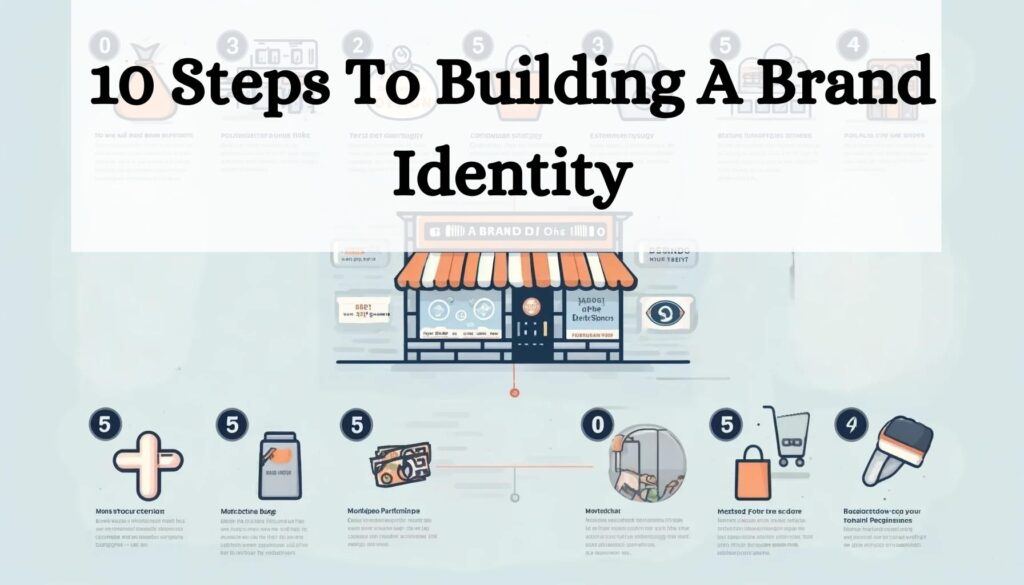Personally, this building a brand has always been hard for me when I started my journey. And I didn’t really know how to build a brand in general. So, if you are like me, I want to help you by showing you how to build an s brand identity!

Key Steps For Building A Brand Identity:
1. Show Your Brands Purpose
2. Identifying Your Targeted Audience!
3. Make Your Brand Special!
4. Your Brands Name & Tagline
5. Find Out Your Brand Positioning
6. The Design
7. Building A Brand Strategy
8. The Consistency of Your Messaging
9. Look At Other Brands: Look For Inspiration
10. Adjust Your Strategies Down The Line
Quick Introduction To Brand Identity!
I’m going to start things off by zeroing in on what a brand identity is and why it carries so much weight in business today. When you’re thinking about how to build a brand identity from scratch, it’s critical to grasp the core of what ‘brand identity’ really means.
This isn’t just about a snazzy logo or a catchy tagline; it’s a combination of all the elements that separate your brand from the crowd.
You’re going to find out about the connection between a rock-solid brand identity and business success. This includes how it fosters recognition, builds customer loyalty, and gives your brand a voice in the global marketplace.
Take a moment to consider some iconic brand identity examples: Apple’s sleek design aesthetic, Nike’s swoosh and ‘Just Do It’ attitude, or Starbucks’ emblematic mermaid. These giants have crafted identities that resonate deeply with consumers, becoming more than just companies; they’re part of our cultural fabric.
Now what is a big publisher? Behance, for example, doesn’t just showcase creative work; it also offers a plethora of Behance brand identity projects that can stir innovation and spark new ideas for your own brand.
In my opinion, understanding the nuances like visual identity vs brand identity is crucial for anyone starting a brand from scratch. Visual identity is just one component of the overall brand identity, albeit a significant one, encompassing elements like logos, typography, and color schemes. It’s the visual representation that will communicate your brand’s values at a glance.
That’s the strategy I like to leverage: using these visual markers as a channel to tell your brand’s story, fostering a connection with your audience that’s both emotive and immediate. In the next section, we’re going to dive into the 10 actionable steps you can take to build this pivotal identity, along with details on how to create a brand identity that’ll stand the test of time.
10 Steps To Building A Brand Identity
I’m going to guide you through a practical roadmap to building a brand identity, breaking it down into 10 key steps. Follow these, and you’re going to find out not only how to create a brand identity, but how to make one that’s strong, resonant, and successful.

1. Show Your Brands Purpose
Start by clarifying your brand’s mission and vision statements; these act as the north star for all your branding efforts, keeping you aligned with your core purpose and future aspirations. In my opinion, without a well-defined mission and vision, a brand can easily lose its way.
I would say that just being clear with what your brand’s purpose is, what are you selling, what niche are you in. Like, you know that Apple sells phones, and you will go there if you like their phones. Be just as clear within your business.
2. Identifying Your Targeted Audience!
Identifying your target audience is critical. Choose something that resonates not just with anyone, but specifically with the people your brand is meant to serve. Pinpointing your market positioning is equally important; know where you stand amidst competitors.
Like if you have a shop where you sell shoes, you will want to target people who want to buy shoes, not the once that wants to buy regular cloths. One way of identifying your targeted audience is by doing some market research. And here is how you can do it:
- Define your objectives: Determine what specific information you need and why you’re conducting the research.
- Identify your target audience: Understand who your potential customers are, their demographics, preferences, and behaviors.
- Choose your research methods: Decide whether you’ll use qualitative methods (like interviews or focus groups) or quantitative methods (like surveys or data analysis).
- Design your research tools: Develop questionnaires, interview guides, or other instruments tailored to gather the information you need.
- Collect data: Execute your research plan by reaching out to your target audience and gathering the necessary information.
- Analyze the data: Organize and interpret the data you’ve collected to extract meaningful insights and patterns.
- Draw conclusions: Based on your analysis, draw conclusions about your market, customers, and potential opportunities or challenges.
- Make strategic decisions: Use the insights gained from your research to inform your business strategy, such as product development, marketing campaigns, or expansion plans.
- Monitor and adjust: Continuously monitor market trends and customer feedback to stay informed and adapt your strategies as needed.
- Repeat as necessary: Market research is an ongoing process, so be prepared to conduct regular research to stay competitive and responsive to changes in the market.
There was a quick guide on how you can do market research. I recommend you finding some more information on how to do it if you want to learn more.
3. Make Your Brand Special!
Craft something special; your brand’s unique value proposition (UVP). What sets you apart in the crowded marketplace? This isn’t just about quality, it’s also about connecting with your audience in a way that’s meaningful to them.
A good example would be Apple and Samsung. 2 very large brands, and people like the other one because they think “well Apple is better!!”, I think you have heard the conflicts between them at least once!
So how you can make your brand special? Here are a few things you can do:
- Have a clean design: If you have a website, or just a shop. Having a clean design can make people feel like home, and that what ever you are doing is good, and high-quality. I would recommend you taking a look at what your competitors have for design, and see if you can do the same or better.
- Make high-quality products: If you ever want to be better then your competitors, then you will want to make high-quality products that people like and find helpful. This way your brands repution will be seen as high-quality. And people spreading the word about how good your brand is, will also mean new happy customers!
- Just be a bit different: If you want to stand out in a good way, you would want to be a bit different from your competitors. So how can you be different without destroying your repution and brand? Simple, ask people. Ask people “Hey! What do you think of YOUR COMPETITOR? What would they need to improve?” And they will respond and you will know what people think that your competitor would need, and you will add it to your brand, and now you have the thing people want. Making you special in a good way. Now if you have a website, then I would recommend creating content around your personality, and make it engaging and high-quality.
That would be my list of things that would make your brand special from the others!
4. Your Brands Name & Tagline
Now, the name and tagline of your brand are your first handshake with the world. They set the tone and create immediate impressions. I really hope that you select a brand name and tagline that reflect your identity and resonate with your audience.
So you would want to have a tagline and name that is relevant to your niche, and with your business. Like our tagline is “learn how to make money your way” and our name is “GettingRichToday”. What does that tell you? Well I would hope that our name and tagline tells you that we will teach you how to make money. And that is what we do.
Sometimes there are exceptions. For example on YouTube, some channels names are not related to the content they make. For example many fitness influencers have their real name as the name of the channel, but people know what type of content they make. And the same thing with a few shops.
But the tagline should always be related to the niche and your brand/business.
5. Find Out Your Brand Positioning
Brand postioning is basically you knowing what postion your brand is compared to your competitors. So what I mean with that is you knowing what your competitors don’t have, and what your business actually have.
So you would want to use this to find out what you will want to have within your business to have a advantage over your competitors. Here is a list of things you could see if you or your competitors have or not:
- Unique Selling Proposition (USP):
- Identify what sets your brand apart from competitors.
- Consider whether your brand offers a unique feature, benefit, or attribute that addresses a specific customer need or pain point not effectively addressed by competitors.
- Market Differentiation:
- Assess how your brand is perceived relative to competitors in the minds of consumers.
- Determine whether your brand is positioned as offering superior quality, value, innovation, customer service, or other distinguishing factors compared to competitors.
- Target Audience Alignment:
- Evaluate how well your brand’s positioning resonates with the needs, preferences, and aspirations of your target audience.
- Ensure that your brand’s unique value proposition addresses the specific desires or challenges of your ideal customers in a way that competitors do not.
- Competitive Analysis:
- Compare your brand’s positioning with that of key competitors to identify gaps, opportunities, and areas of strength.
- Analyze competitors’ messaging, product offerings, pricing strategies, distribution channels, and customer perceptions to uncover potential areas for differentiation.
- Brand Perception and Reputation:
- Assess how your brand is perceived by customers, industry influencers, and other stakeholders relative to competitors.
- Monitor online reviews, social media sentiment, brand mentions, and industry rankings to gauge your brand’s reputation and identify opportunities for improvement or enhancement.
If your competitors don’t have one of these, but you having all 5, will give you a HUGE advantage. So make sure that your business as all of these points. Now don’t forget the common things like good service, price overall good experience for the customers.
6. The Design
Move on to design elements. Design a logo that’s not just visually appealing, but also encapsulates your brand ethos. Choose a color palette that conveys your brand’s vibe effectively. This, along with your chosen fonts, imagery, and icons, forms the core of what to include in a visual identity.
My recommendations for a logo would be to have something simple but stylish. Nike, Apple are good example of simple logos. You can use Canva.com for desgining a good looking logo, and yes it is free.
When it comes to design of your store, shop, website, etc. Keep it simple, and modern, and modern colors.
This tends to work, and in my experience modern colors makes your site, or store/shop look professional and can give a good first impression.
7. Building A Brand Strategy
Let’s talk about how to build a brand strategy. This is the framework that guides the practical implementation of your brand identity elements. Your strategy will tell you how you’ll communicate your brand’s voice and values across every customer interaction.
So basically, this will by your strategy to “tell” your potencial customers about your brand. So this will be the part where your logo, tagline, name, colors, theme, will play their part. But you will also build up a strategy to introduce your brand, here are a few things you can include in to your plan:
- Brand Storytelling: Craft a compelling narrative that communicates your brand’s history, values, and mission in a way that resonates with your target audience. Use storytelling to humanize your brand and create emotional connections.
- Visual Identity: Develop visual elements such as logos, colors, fonts, and imagery that represent your brand’s personality and values. Ensure consistency in visual branding across all communication channels.
- Tagline: Create a memorable and concise tagline that encapsulates your brand’s essence and communicates its unique value proposition to potential customers.
- Naming Strategy: Choose a brand name that is easy to remember, pronounce, and reflects your brand’s identity and positioning in the market.
- Color Palette: Select a color palette that conveys the desired emotions and associations related to your brand. Different colors evoke different psychological responses and can influence how your brand is perceived.
- Theme and Design Elements: Develop a cohesive theme and design elements for your brand introduction materials, such as website, social media profiles, marketing collateral, and packaging. Ensure that these elements align with your brand identity and create a consistent brand experience.
- Target Audience Analysis: Understand your target audience’s demographics, preferences, needs, and pain points. Tailor your brand introduction strategy to resonate with their interests and aspirations.
- Communication Channels: Determine the most effective channels to reach your target audience and introduce your brand, such as social media, email marketing, influencer partnerships, events, or traditional advertising.
- Launch Plan: Develop a detailed plan for launching your brand introduction campaign, including timelines, milestones, budgets, and key performance indicators (KPIs) to measure success.
- Engagement Strategy: Create opportunities for audience engagement and interaction to build awareness and foster relationships with potential customers. This could include interactive content, contests, giveaways, or community-building initiatives.
- Feedback Mechanisms: Establish mechanisms for gathering feedback from your audience during the brand introduction phase. Listen to their opinions, preferences, and concerns to refine your strategy and messaging accordingly.
- Adaptation and Iteration: Remain flexible and open to adjustments based on the initial response to your brand introduction efforts. Continuously monitor performance metrics and feedback to refine your approach and optimize results.
This list might look a bit long, but it is helpful. A few things have we already discused, but they are important.
8. the consistency of your messaging
It’s important to ensure the consistency of your messaging across all platforms and points of contact. Achieve this, and your brand starts to become recognizable; skip this, and the market will be confused about who you are.
You will want people to recongnize you and your brand. This is what really builds that brand identity you are looking for!
9. Look At Other Brands: Look For Insperation
You’re also going to appreciate brand identity examples of established companies. Take a look at brands with strong visual identities on platforms like Behance; it’s a wonderful source of inspiration and a testament to the power of creative brand building.
I would recommend you only taking insperations from companies that are in your niche, because that will be the most relevant once. It is very important that you DON’T copy what they are doing. Yes, I know that it might be a bit hard coming up with new ideas, and don’t use GPT for this, please! It won’t work so well.
Only take insperations. I have helped people who are a bit new to this, and they use to much AI, and copy what other people are doing. It is important that you are you, insperation isn’t bad. Just don’t copy what they are doing, ok? Just see what they are doing and then tailor it for your business.
10. Adjust Your Strategies Down The Line
Lastly, remember that your brand identity isn’t static; it should evolve as your business and the market do. Regularly evaluate and adjust your branding to stay relevant and resonate with your audience. Your first attempt doesn’t need to be your last – brands, like all things, evolve.
The Benefits Of Brand Identity!
Now when we have gone through how you can build a brand identity. Let’s talk about the real benifits of brand identity, and what this really does to your business.

Building a Foundation For Your Business
Brand identity is about building a foundation for your business. A foundation that is relevant to your business, the values and the messages from your business. And helps you getting long-term relationships with customers.
Makes It Clear About Who You Are
Brand identity also makes it clear to you, your business (employes, and the people working their) who you are, and for all of the customers too. Remember that this didn’t happen over night. These large brands like Nike, Apple, or Startbucks also started form zero, just like you. It just takes time and effort. NEVER give up!
In closing, building your brand identity from scratch is a journey filled with introspection and creativity. It’s a strategic endeavor that, when done correctly, can differentiate you in a crowded market and build lasting loyalty.
Remember the steps we discussed: clarifying your vision, understanding your audience, crafting your message, and consistently applying your visual elements. Look for inspiration on platforms like Behance, reflect on the examples of successful brand identities, and don’t shy away from iterating as you grow.
The End Of The Article: Final Thoughts!
Your first attempt doesn’t need to be your last. Building a brand identity is an ongoing process of reflecting the changing landscapes of the market and your company’s growth.

So take these insights, let them influence your strategy, and watch as a well-defined brand identity takes shape, bringing your business’s personality to life and capturing the hearts of consumers worldwide. To sum it up, to build a brand identity you will need to:
- Show Your Brands Purpose
- Identifying Your Targeted Audience!
- Make Your Brand Special!
- Your Brands Name & Tagline
- Find Out Your Brand Positioning
- The Design
- Building A Brand Strategy
- The Consistency of Your Messaging
- Look At Other Brands: Look For Inspiration
- Adjust Your Strategies Down The Line
I really hope that this article was helpful! I got one thing left for you, and that is a FAQ section where I will be answering common question around the topic of how to build a brand identity!
FAQ’s Around How To Build A Brand Identity
How to increase brand identity?
If you want to increase brand identity, there are a few steps for doing. Firstly you will want to show your brand purpose. Show what you have to give and what you do. Next use logos and colors to kinda tell a customer what your brand really is, use relevant colors. Then there are things like delivering high-quality products/services, and overall good user experience.
What are the four major components to building brand identity?
The four major compentents of building a brand identity are:
1. Brand strategy
2. Visual identity
3. Messaging
4. Brand experience
All of these compentents helps your customers understanding your brand, what you guys are delivering, and kinda just who you are.
What makes an effective brand identity?
An effective brand identity is characterized by its memorability, cohesiveness, authenticity, differentiation, and engagement. It is easily recognizable and consistent across all touchpoints, authentically reflecting the brand’s values and personality while setting it apart from competitors and engaging the audience emotionally to drive loyalty and preference.
What is a strong brand image?
A strong brand image is the perception or impression that consumers have of a brand based on their experiences, interactions, and associations with the brand. It reflects the brand’s reputation, values, personality, and identity in the minds of consumers, inspiring trust, loyalty, and positive attitudes that drive preference and purchase decisions.
How do I find my brand identity?
Finding your brand identity involves defining your brand’s purpose, understanding your target audience, researching your competitors, developing a visual identity and messaging that aligns with your brand’s values and resonates with your audience, and consistently delivering on your brand promise across all customer touchpoints.






